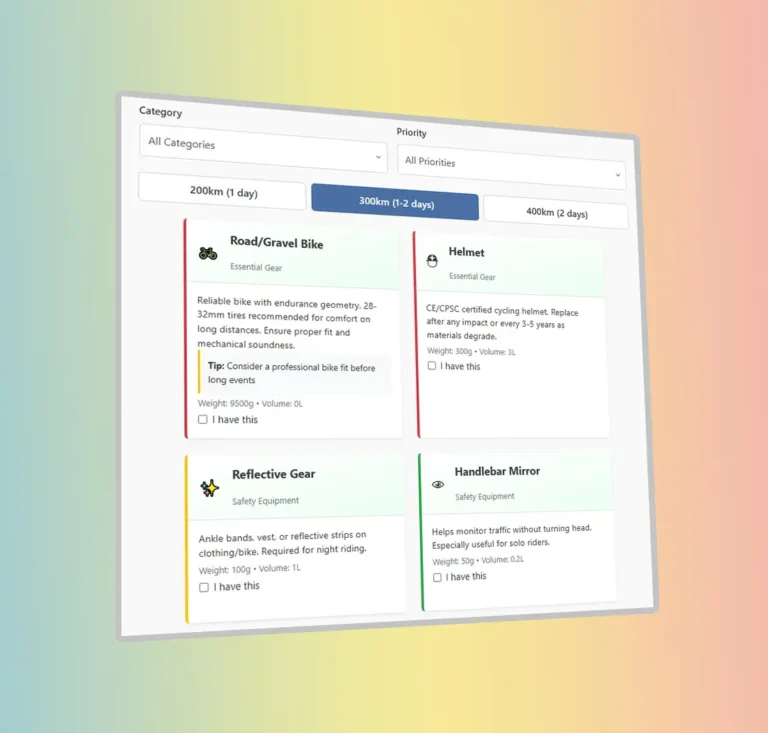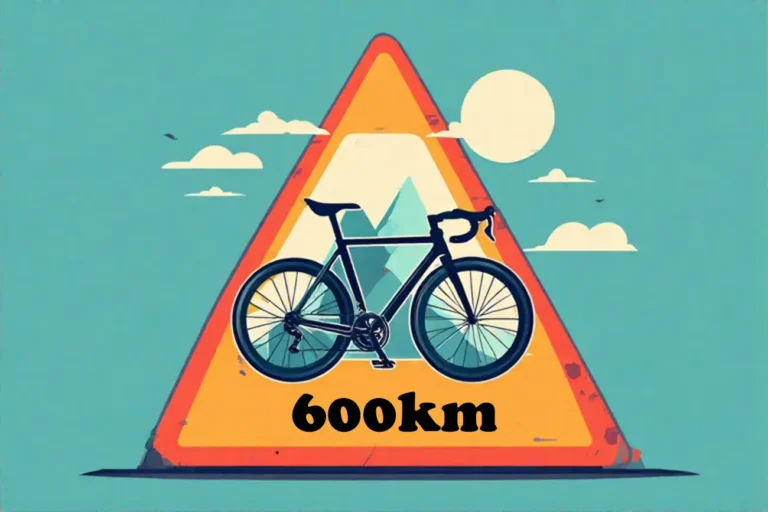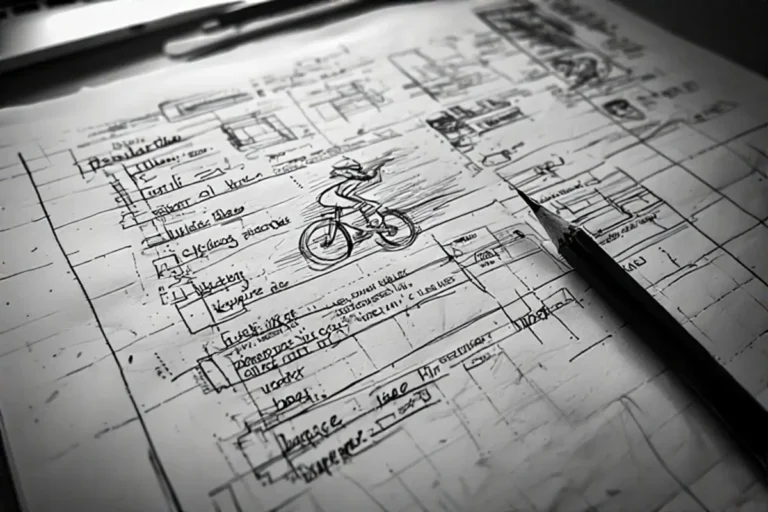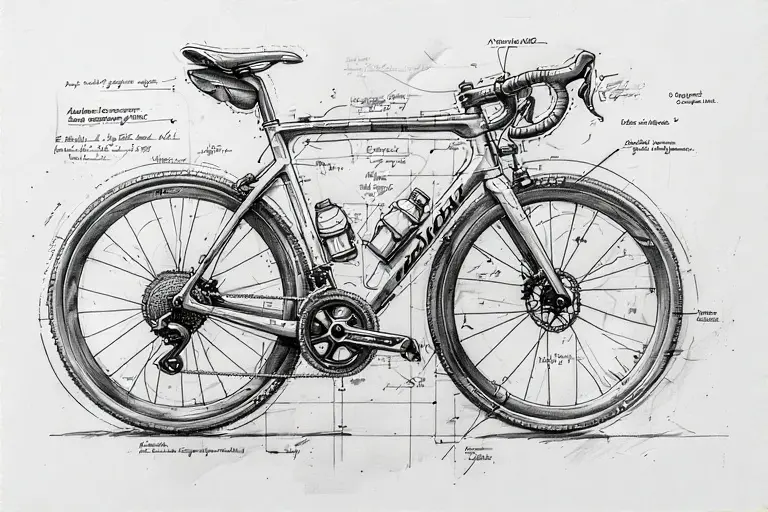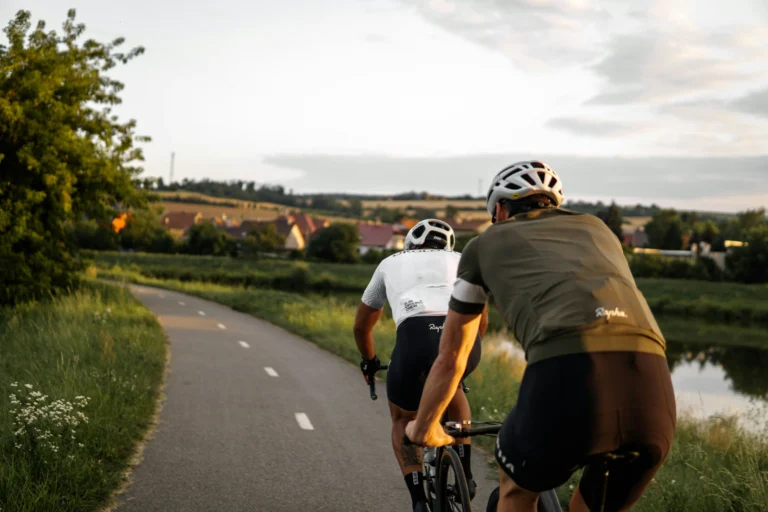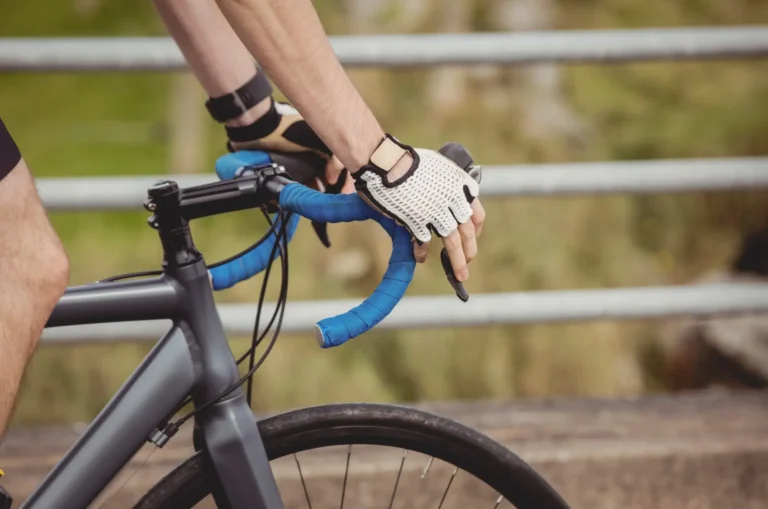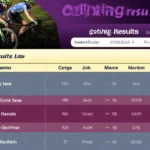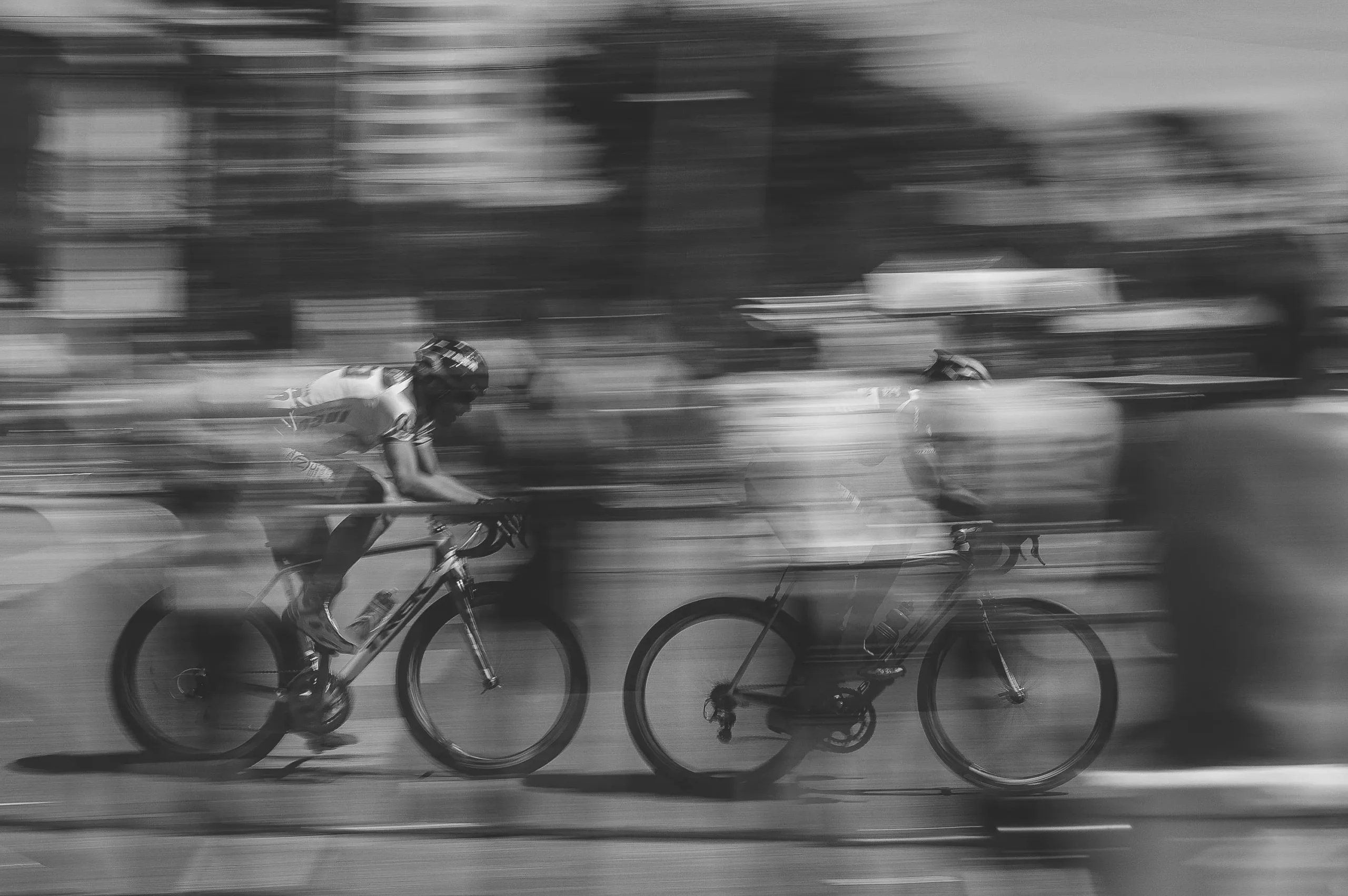
The Complete Audax Cycling Training Guide – Ride Farther, Stronger & Smarter
Long-distance cycling is as much about preparation as it is about pedaling. Whether you’re preparing for your first 200km brevet or training for a 1200km epic, this comprehensive guide will take you through everything you need to know – from building endurance and dialing in nutrition to mastering the mental game and optimizing recovery.
Section 1: Building Your Endurance Foundatio
Why Base Training Matters
Audax events demand sustained aerobic endurance. Unlike short, intense races, success comes from efficient energy use over many hours. Building a strong aerobic base allows you to ride longer while delaying fatigue.
How to Build Your Base
1. Consistency is Key
• Aim for 4-6 rides per week (mix of short, medium, and long rides)
• Even 30-60 minute easy rides maintain fitness when time is limited
2. The 10% Rule
• Never increase weekly distance by more than 10% to avoid overuse injuries
• Example: If you ride 200km this week, cap next week at 220km
3. Zone 2 Training (60-70% Max HR)
• 80% of your training should be at a conversational pace
• This builds mitochondrial density and fat-burning efficiency
4. Incorporate Hills
• Even if your event is flat, hills build leg strength and cardiovascular fitness
• Try 2-3 short hill repeats (5-8% grade) during weekday rides
Pro Tip: Use a commute or errand run as an easy endurance ride – it adds volume without requiring extra time.
• Aim for 4-6 rides per week (mix of short, medium, and long rides)
• Even 30-60 minute easy rides maintain fitness when time is limited
2. The 10% Rule
• Never increase weekly distance by more than 10% to avoid overuse injuries
• Example: If you ride 200km this week, cap next week at 220km
3. Zone 2 Training (60-70% Max HR)
• 80% of your training should be at a conversational pace
• This builds mitochondrial density and fat-burning efficiency
4. Incorporate Hills
• Even if your event is flat, hills build leg strength and cardiovascular fitness
• Try 2-3 short hill repeats (5-8% grade) during weekday rides
Pro Tip: Use a commute or errand run as an easy endurance ride – it adds volume without requiring extra time.
Section 2: The Long Ride – Your Most Important Training Tool
Why Long Rides Are Non-Negotiable
Your body needs to adapt to:
• Saddle time (preventing numbness and discomfort)
• Metabolic efficiency (teaching your body to burn fat)
• Mental stamina (handling hours of continuous effort)
• Saddle time (preventing numbness and discomfort)
• Metabolic efficiency (teaching your body to burn fat)
• Mental stamina (handling hours of continuous effort)
Structuring Your Long Rides
1. Progressive Distance Buildup
• Start at 50-60% of your target distance
• Example: For a 300km brevet, build up to at least one 180-200km ride
2. Pacing Strategy
• Ride at 75-80% of your threshold – you should be able to speak in short sentences
• Going too hard early leads to late-ride exhaustion
3. Event Simulation
• Train in similar weather, terrain, and time of day as your event
• Practice using your lights, bags, and nutrition setup
4. Back-to-Back Long Rides
• Try a long Saturday ride + medium Sunday ride (e.g., 150km + 80km)
• Mimics multi-day events and teaches your body to ride fatigued
Pro Tip: Schedule one “monster ride” 3-4 weeks before your event – this builds confidence.
1. Progressive Distance Buildup
• Start at 50-60% of your target distance
• Example: For a 300km brevet, build up to at least one 180-200km ride
2. Pacing Strategy
• Ride at 75-80% of your threshold – you should be able to speak in short sentences
• Going too hard early leads to late-ride exhaustion
3. Event Simulation
• Train in similar weather, terrain, and time of day as your event
• Practice using your lights, bags, and nutrition setup
4. Back-to-Back Long Rides
• Try a long Saturday ride + medium Sunday ride (e.g., 150km + 80km)
• Mimics multi-day events and teaches your body to ride fatigued
Pro Tip: Schedule one “monster ride” 3-4 weeks before your event – this builds confidence.
Section 3: Nutrition & Hydration – Your Invisible Fuel Tank
The Science of Cycling Nutrition
• At endurance pace, your body can only store ~2,000 calories of glycogen
• You must refuel 200-400 calories per hour to avoid bonking
• You must refuel 200-400 calories per hour to avoid bonking
On-Bike Nutrition Plan
1. Carbohydrates (30-60g per hour)
• Mix fast-acting (gels, sports drinks) and slow-release (bars, bananas) carbs
• Real food options: Sandwiches, rice cakes, dried fruit
2. Hydration (500ml-1L per hour)
• Drink before you’re thirsty – dehydration kills performance
• Add electrolytes in hot weather or for rides over 4 hours
3. Caffeine Strategy
• Save caffeine for the second half of long rides (100-200mg)
• Reduces perceived effort and sharpens focus
Pro Tip: Practice eating while riding – it’s a skill that saves time during events.
• Mix fast-acting (gels, sports drinks) and slow-release (bars, bananas) carbs
• Real food options: Sandwiches, rice cakes, dried fruit
2. Hydration (500ml-1L per hour)
• Drink before you’re thirsty – dehydration kills performance
• Add electrolytes in hot weather or for rides over 4 hours
3. Caffeine Strategy
• Save caffeine for the second half of long rides (100-200mg)
• Reduces perceived effort and sharpens focus
Pro Tip: Practice eating while riding – it’s a skill that saves time during events.
Section 4: Mental Toughness – Training Your Brain
Why the Mind Gives Up Before the Body
Studies show endurance athletes typically have 40-60% more in the tank when they think they’re exhausted.
Mental Training Techniques
1. Segmentation
• Break the ride into 20km chunks or between checkpoints
2. Embrace Discomfort
• Practice riding in rain, wind, and heat – it builds resilience
3. Positive Self-Talk
• Develop mantras: “This is temporary”, “Keep turning the pedals”
4. Visualization
• Spend 5 minutes daily picturing yourself riding strong and finishing
Pro Tip: Listen to audiobooks or podcasts on solo long rides – they make time pass faster.
• Break the ride into 20km chunks or between checkpoints
2. Embrace Discomfort
• Practice riding in rain, wind, and heat – it builds resilience
3. Positive Self-Talk
• Develop mantras: “This is temporary”, “Keep turning the pedals”
4. Visualization
• Spend 5 minutes daily picturing yourself riding strong and finishing
Pro Tip: Listen to audiobooks or podcasts on solo long rides – they make time pass faster.
Section 5: Strength, Mobility & Recovery
Off-the-Bike Training
1. Core Work (3x/week)
• Planks, dead bugs, Russian twists (15-30 minutes)
2. Leg Strength (2x/week)
• Squats, lunges, calf raises (bodyweight or light weights)
3. Mobility & Stretching
• Daily 10-minute routine focusing on hips, hamstrings, and back
• Planks, dead bugs, Russian twists (15-30 minutes)
2. Leg Strength (2x/week)
• Squats, lunges, calf raises (bodyweight or light weights)
3. Mobility & Stretching
• Daily 10-minute routine focusing on hips, hamstrings, and back
Recovery Protocols
1. Sleep (7-9 hours/night)
• Growth hormone (for muscle repair) peaks during deep sleep
2. Active Recovery
• Light spinning (Zone 1) or walking boosts circulation
3. Compression & Ice
• Compression socks and occasional ice baths reduce inflammation
Pro Tip: Keep a training log to track progress and avoid overtraining.
• Growth hormone (for muscle repair) peaks during deep sleep
2. Active Recovery
• Light spinning (Zone 1) or walking boosts circulation
3. Compression & Ice
• Compression socks and occasional ice baths reduce inflammation
Pro Tip: Keep a training log to track progress and avoid overtraining.
Section 6: Event Preparation & Strategy
Final 4 Weeks Before Your Brevet
1. Peak Week
• Longest ride 3 weeks out, then taper
2. Bike Check
• Service bearings, replace chain if worn, check brake pads
3. Kit Test
• Ride in your full event outfit to check for chafing
• Longest ride 3 weeks out, then taper
2. Bike Check
• Service bearings, replace chain if worn, check brake pads
3. Kit Test
• Ride in your full event outfit to check for chafing
During the Event
1. Start Slow
• First 25% should feel too easy
2. Checkpoint Strategy
• Limit stops to 15-20 minutes max to avoid stiffening up
3. Night Riding
• Use two headlights (one as backup) and reflective gear
Pro Tip: Pack a “good mood” snack – something you really enjoy for tough moments.
• First 25% should feel too easy
2. Checkpoint Strategy
• Limit stops to 15-20 minutes max to avoid stiffening up
3. Night Riding
• Use two headlights (one as backup) and reflective gear
Pro Tip: Pack a “good mood” snack – something you really enjoy for tough moments.
Final Thoughts: The Audax Mindset
Audax isn’t about speed – it’s about perseverance, preparation, and the joy of the journey. Every kilometer you ride in training makes you stronger, both physically and mentally.
Your Next Steps:
1. Pick a goal event
2. Create a 12-week training plan using these principles
3. Join our club rides to learn from experienced randonneurs
The road is calling – how far will you go?
Join Our Club | Event Calendar
Need personalised advice? Our veteran riders are happy to help – contact us today!
Your Next Steps:
1. Pick a goal event
2. Create a 12-week training plan using these principles
3. Join our club rides to learn from experienced randonneurs
The road is calling – how far will you go?
Join Our Club | Event Calendar
Need personalised advice? Our veteran riders are happy to help – contact us today!

